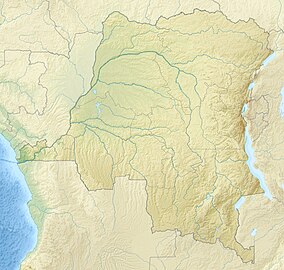Maiko National Park
| Maiko National Park | |
|---|---|
|
IUCN category II (national park)
|
|
| Location | Democratic Republic of the Congo |
| Nearest city | Kisangani |
| Coordinates | 0°24′S 27°34′E / 0.400°S 27.567°ECoordinates: 0°24′S 27°34′E / 0.400°S 27.567°E |
| Area | 10,885 km2 (4,203 sq mi) |
| Established | 1970 |
| Governing body | Institut Congolais pour la Conservation de la Nature (ICCN) |
| WDPA 1080 | |
Maiko National Park is a national park in the Democratic Republic of the Congo. It lies in one of the most remote forest areas of the country and covers 10,885 km2 (4,203 sq mi). The park is divided into three sectors, straddling the states of Nord Kivu, Province Orientale and Maniema. Three of the country's spectacular endemic animals occur here: the Grauer's gorilla, the okapi, and the Congo peafowl. Maiko is also an important site for the conservation of the African forest elephant, eastern chimpanzee and the endemic aquatic genet.
In 1949, the Belgian colonial administration created the Bakumu Hunting Reserve (Bakumu, meaning "The Kumus", the native tribe in the region) on an area that would later encompass the boundaries of the Park as we know it today. The original plans for the area is believed to have aimed at preventing the exploitation of mineral resources rather the protection of the nature and the wildlife. On November 20 of 1970, the Presidential Decree no 70-312 which is bound to the law that had created the ICCN previous year, was signed into force by Joseph Désiré Mobutu. This document asserted the Maiko National Park to be a full-fledged nature protection area.
The roadless and inaccessible nature of the region made it ideal for some Simba rebels to retreat after their defeat in 1964. Ever since, they have been making a meager living by poaching on wildlife and controlling illegal mining activities inside of Maiko. The presence of the Simba also stems from the inability of the governing bodies to follow the compensatory measures required by the decree of 1970. This precarious security situation have made it difficult for the rangers to patrol the Park, especially after the ICCN was coerced by the Congolese army into guiding their attacks towards the Simba. Moreover, conservation work has also been hampered by the presence of rebels, culminating in capture and detainment of several survey crews between 2003 and 2005. At least three other rebels groups are known to be active in different parts of the park, among which the Rwandan Interahamwe in the east. Put together, these menaces leave absolutely no control over the park area by the ICCN.
...
Wikipedia

